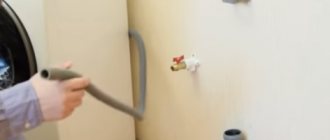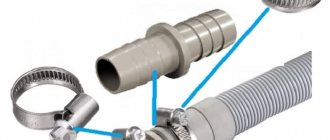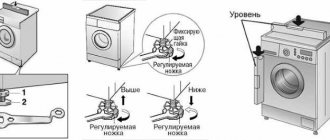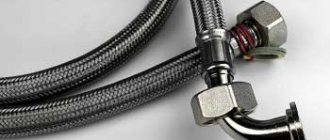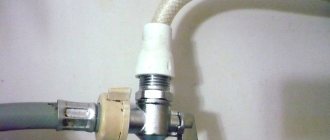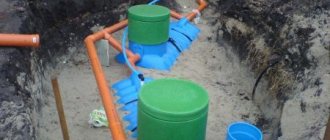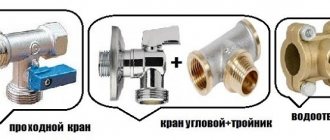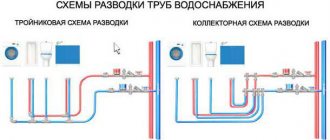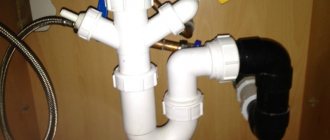Author's rating
Articles written
698
Author of the article
Vasily Mikhailovich Sviridov
home appliance repair technicians Salary from 80,000 rubles!
Published: 19-10-2018
Modified: 19-10-2018
Reading time: 6 minutes
This article has: (i)
As the weather warms up, crowds of summer residents rush out of town. A garden, a vegetable garden, fresh herbs - all this requires care. But you also have to think about cleanliness. Water supply has not yet reached all villages and settlements. It happens that in the private sector there is no centralized water supply. How to connect a washing machine without running water if you want to use an automatic drum-type machine rather than a regular activator machine?
In what cases is it necessary to connect a machine without running water?
Modern equipment allows even in the country to create normal conditions for the high-quality operation of any automatic washing machine. To do this, we need to remember the principle of operation of such devices.
How does a washing machine work?
An automatic washing machine (AWA) is an intelligent household appliance that can perform its duties with just three connections:
- to an AC electrical network with a voltage of 220 volts;
- to a source of clean water supplied with sufficient pressure to dissolve detergents and fill the tank with pressure;
- to the place where waste solutions are drained.
Washing machine operating diagram
All actions of the machine are controlled by a control unit that gives commands to the engine that rotates the drum, the pump that pumps out the liquid, the valves and sensors that regulate the process of filling the tank with liquid. After loading the laundry and pouring the powder into a special bath, the valve on the water supply line opens. She washes off the powder and fills the tank to a certain level. The heating element is responsible for heating it.
The processes of soaking, washing and spinning occur when the drum rotates at the required speed. During operation, water is pumped out of the machine several times, taking with it all foreign matter. As a result, the housewife takes out slightly damp, clean linen, which only needs to be dried and ironed.
For information! Some models are capable of dispensing items in a dried state without creasing.
It turns out that there are almost no problems with these connections in rural areas. Electrification is everywhere. During power surges, you can use a gasoline or diesel power generator. To drain dirty solutions, there are septic tanks or cesspools, and to supply water there are a lot of technical devices that create the necessary pressure. You just need to know how to connect your washing machine without running water.
Benefits of using SMA without running water
The operation of automatic washing machines in villages that do not have a centralized water supply can provide their owners with tangible benefits:
- You can use rainwater, which is considered the softest and purest. It allows you to wash things efficiently using a minimum of detergents. At the same time, scale does not form on the heating element, which extends its service life.
- There is no need to pay for using water from your own well or borehole, and this is a direct saving on the family budget.
- The old model, which you considered unsuitable for a city apartment, can serve in the country for many years.
If you value convenience, then you can safely bring new or used equipment to your country house, knowing exactly how to connect a modern automatic washing machine without running water.
Installation of a compact blower
The easiest way to connect a washing machine is with a small-sized and inexpensive pressure pump. In this case, a simple scheme is used. It consists of three elements: a water tank – a pump – a washing machine hose.
You need to purchase the pumping device itself (it costs no more than 1 thousand rubles), adapters for it, two meters of cable (with two cores) and silicone-based sealant (with its help you will fix the adapters). It is advisable to buy a pump of the same brand as your automatic washing machine. In this case they will be completely compatible.
Pumping device for connecting an automatic washing machine
Important nuance! The pumping device should be taken with a cover (assembled). If you are offered only an impeller and a motor, refuse such a purchase. Most modern washing machines have a water supply hose with a 3/4 inch thread. The pump does not have such a connection. Therefore, adapters need to be purchased specifically for 3/4 inches. You can stock up on sealant at any auto store. Buy the silicone compound that you like.
Next, do everything according to the given scheme:
- Make a hole in the water container using a regular electric drill and install adapters into it.
- Be sure to treat the entry point of the transition devices with sealant. This compound will take about 22–24 hours to dry.
- Use coarse sandpaper to clean the tubes on the purchased pump that are necessary for connecting the adapters. Lubricate the latter with sealant and pull them onto the tubes.
- Solder (or connect with terminals) the wires going to the pump contacts. This area should be additionally protected with special tubes (they are called heat-shrinkable).
- Wait for the silicone adhesive to dry, and then connect the pump to the washer.
Now feel free to start the washing machine (don’t forget to fill the container with water). When the unit needs water, you will need to connect the installed pump to a 220-volt outlet. That's all. Use your washing assistant in a country house where there is no running water.
Options for connecting an automatic machine without running water
An automatic washing machine without connection to the central pipeline can be used in various ways. Which one is right for you, decide for yourself.
Container for detergents
The simplest material method for supplying clean water to a tank is to manually pour it through a slightly open container for powder and special solutions. It does not require any technical tricks, but requires constant human participation. He will have to add water from a bucket or other container every time it is required in accordance with the selected program.
Come to think of it! In this case, the very meaning of using an automatic machine disappears. Soon the owner has a desire to purchase a simple activator-type equipment.
Container with water
The next option involves installing a small tank or container at some elevation, connecting it with a pipe or hose to the inlet pipe of the machine. It will be able to operate as usual, and the flow of water will be carried out by gravity. Despite the reasonableness of the approach, this method has significant disadvantages:
- To create a pressure sufficient to wash off the powder, you will need to raise the container to a height of about 10 meters. Agree that not every dacha has such dimensions, and building a special water tower is not the cheapest solution.
- Not every adherent of such “automation” of household work will be ready to carry about 100 liters of water needed for each wash in buckets.
Well drilling
Almost all issues with providing household appliances with cold water are resolved by a device located in a suburban area of an artesian well.
It is equipped with a pumping station that maintains operating pressure automatically. In this case, connecting a washing machine in a house without running water will not differ from a standard installation somewhere in a city apartment. This method has two disadvantages:
- The aquifer may be deep. Then drilling a well and installing a powerful pump will cost a lot of money.
- Water from a well may contain dissolved mineral salts, which will negatively affect the operation of the heating element and cause premature corrosion of the equipment.
Using the pump
If the main thing for the normal operation of an automatic machine is a stable supply of clean water with the required pressure, then even the simplest centrifugal pump, turned on during washing, will be a simple solution to the problem. To do this, it is enough to place it in a nearby drinking well or connect it to a small container installed next to the SMA. On a note! For these purposes, you can use a stationary surface or submersible pump that creates a discharge pressure of at least one atmosphere.
Using the pump
According to experts, a pressure pump for a washing machine is the most optimal and acceptable way to connect equipment in a place where there is no running water. To do this, you will need to install a barrel near the machine, install a tap in it, to which connect a hose with a pressure pump.
In addition to the fact that this method is effective, there are practically no costs for implementation.
What tools to use to connect an automatic machine without running water
To install a machine without running water, you need to know what tools and parts should be on hand.
You can buy in advance in the store those parts that you will not find in the garage or at the dacha. So, the tools you will need are a small adjustable wrench, an indicator screwdriver and pliers. Also, for measuring work, stock up on a tape measure and a building level. You can't do without a good knife and tape for sealing.
You may not have the following items at home:
- solenoid valve;
- 3/4 inch tee tap;
- injection pump;
- gaskets and clamps;
- flow filters;
- hoses for organizing water supply.
Be sure to prepare for this process. It’s better to leave the extra parts - everything will be useful on the farm.
Important! The dimensions of the hose depend on the model of the machine. During installation, certain difficulties may arise, so it is very difficult to predict them.
Self-connection of the washing machine without running water
Now let's talk about how the automatic washing machine is connected. As you already understand, some difficulties may arise in the process, so we offer a general description.
Follow these steps:
- Select installation location. The floor in the room should be perfectly flat, preferably concrete. In this case, there must be sockets located nearby.
- Place a 50-liter barrel next to the washing machine.
- For convenience, the barrel should have a hinged lid - you won’t have to spend a lot of time filling the container.
- Make a wooden stand 50-100 cm high - place the barrel on it.
- In the wall of the tank from the very bottom, make a 3/4-inch hole for the tap thread, insert the rubber gasket and install the tee tap.
- Attach the discharge pressure hose to the faucet and connect it to the pump.
- Connect the discharge hose using an adapter to the CMA intake hose.
Important! To ensure tight connections, tighten the clamps tightly.
- Remove the top panel of the washer, find the solenoid valve and pull out the seals from it - this is necessary for better throughput.
- Install a flow filter in front of the valve.
- Test the machine.
Now you know that the lack of running water is not a problem when installing an automatic washing machine, because you can solve it too. The main thing is to approach this task correctly.
Connecting an automatic machine without running water
You should consider in more detail the question of how to connect your automatic machine without running water using a simple pump. You can do all the work yourself, but you need to prepare well for it.
Required tools and accessories
Before you start, you should have on hand:
- a container made of durable material with a volume of at least 100 liters;
- any centrifugal pump that can be purchased inexpensively at a specialty store (a small pump for watering a garden is also suitable);
- a hose corresponding to the diameter of the pump nozzles;
- valve and a metal fitting to it with an external thread, rubber gaskets and locknuts of the same diameter for fastening to the container;
- adapter with ¾-inch thread for connecting the inlet hose of the washing machine;
- set of clamps;
- drill;
- two adjustable wrenches;
- two-core electrical cable;
- screwdriver;
- silicone sealant.
Necessary materials
The procedure should be as follows:
- The washing machine is installed in a place convenient for use. There should be an electrical outlet nearby and a drain for pumping out waste water.
- A barrel is placed in close proximity to it at a height of at least 50 cm. A stool or an old bedside table that can support a weight of about 100 kg is suitable as a support for it.
- A hole equal to the outer diameter of the fitting is drilled in the bottom of the barrel.
- A fitting with a valve screwed onto it is inserted there. It is fixed on both sides with locknuts with spacers placed under them.
Self-connection of the washing machine without running water
Advice! To make access to the valve easier, you can make a small cutout in the stool or cabinet, which should not affect the strength and stability of the support.
- The tightness of the connection is checked by pouring water into the barrel. If a leak is discovered that cannot be eliminated by tightening the nuts, you will have to drain the water and reinstall the fitting with silicone added under the locknut. In this case, you need to let it dry before the next filling.
- Using hoses and clamps, a circuit for supplying water from the barrel through the pump to the machine is assembled.
- The body of the machine is opened. To automatically synchronize the activation of the pump, its motor is connected to the wires going to the solenoid valve, which opens the water supply to the detergent bin.
- Clean water is poured into the container. The machine is connected to the network. A trial run is being carried out.
Every time, in accordance with the program, the machine needs to fill the tank with water, the standard valve will simultaneously open and the pump will turn on. When a certain level is reached, the electrical circuit opens, the valve closes, and the pump stops.
Intermediate pump installation
Before connecting an automatic washing machine without running water , you will need to prepare several things. The first will be a container for liquid. The best solution, which is popular among all summer residents, is to install a two hundred liter barrel near the washing machine. Units with economical washing systems can get by with a hundred-liter barrel, but the supply of water will never be superfluous.
Important:
It is worth noting the fact that many experts recommend using ordinary aquarium pumps. Their price is much lower than the above units, and you will need to direct the hose directly into the powder chamber.
In order not to overload the unit system, it is recommended to embed the ball valve exclusively at the base of the barrel. It is from this that the hose will go to the inlet of the washing machine.
You will need to connect the pump to the power supply, but you need to do this in such a way that it is activated only when necessary. The solenoid valve operates from a regular 220V network and will remain closed when not in use. To open it, you need to apply voltage directly to the coil. To do this, you will need to remove the top cover of the washing machine and simultaneously connect the pump to the inlet solenoid valve.
You can do this directly at the terminal of the valve itself. Or find where the cable is laid and connect the valve together with the pump on the terminal block; most often it is located at the bottom of the unit; this can be done using pliers.
After completing all the operations, you will receive a completely working washing machine that does not require a connection to the water supply.
